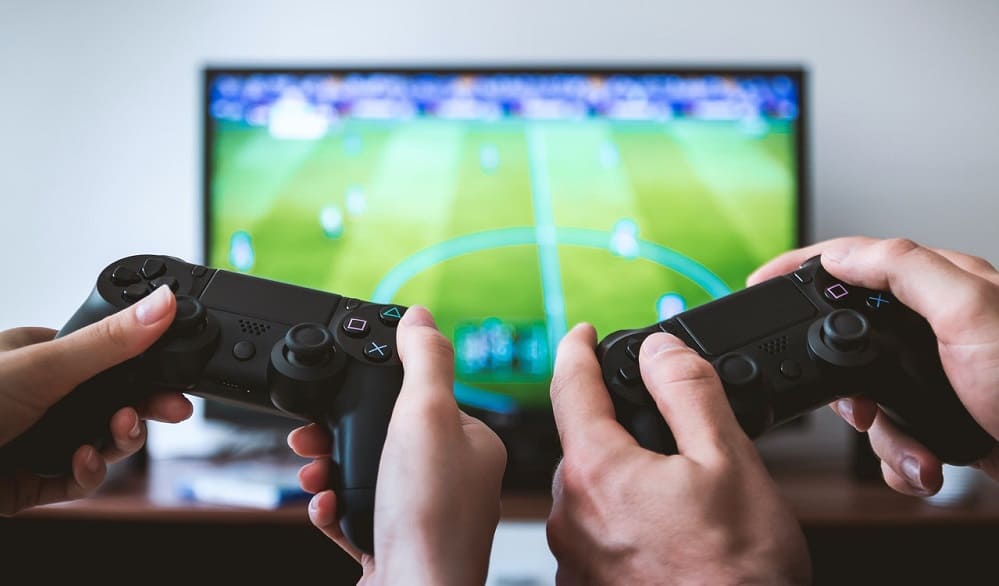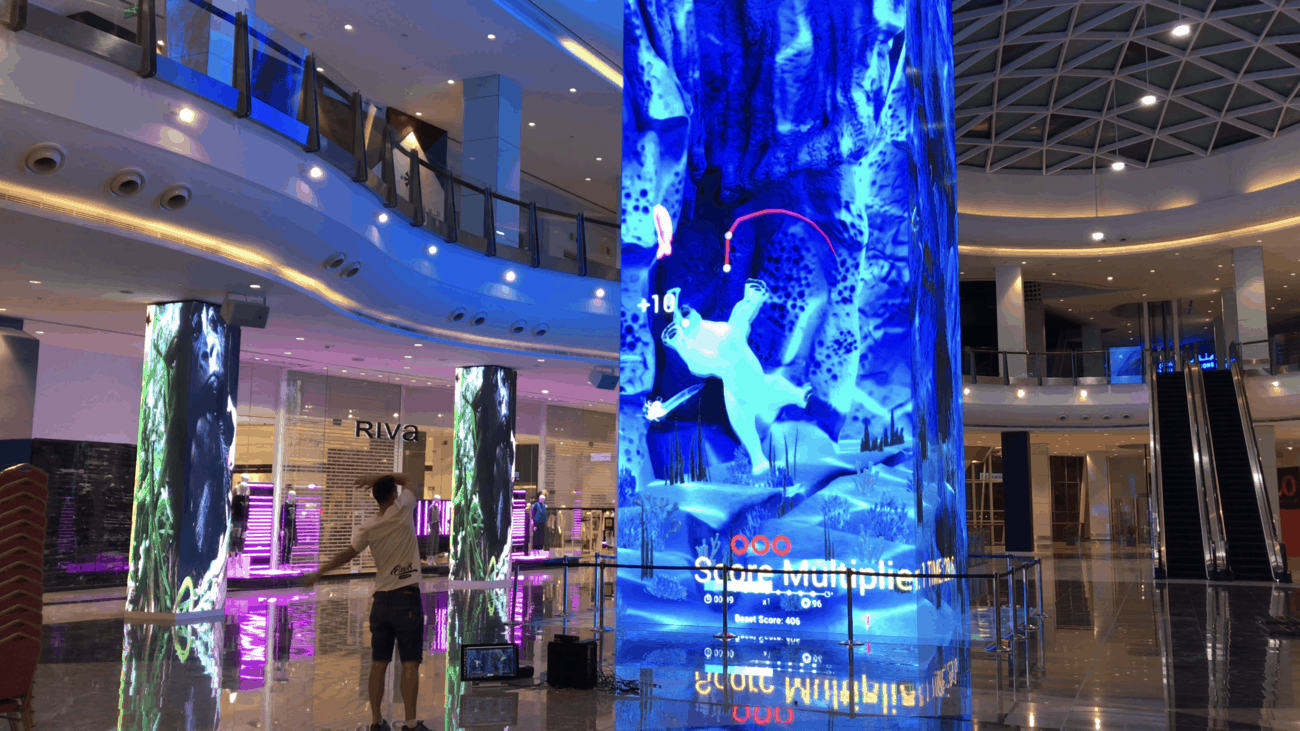There’s a reason why gaming pros all opt for specialist gaming monitors and elaborate setups.
If you want to be the best, you’ll have to use the best equipment and enhance your experience by gaming on a large screen. You may be asking yourself what’s the difference between gaming on a large LED display versus your standard gaming monitor.
“Well ask yourself, do you prefer playing up close and personal to your screen or would you rather lounge back on the couch or in the bed and play on LED display the size of your whole wall?”
It all depends on your personal preference. While there are some significant differences between large LED displays and standard gaming monitors, you want to be honest with yourself in determining what better suits your gaming personally.
Regardless of whether you prefer gaming on a standard PC monitor or a large LED display, one important thing is the quality of your screen’s output. We know you just purchased that high-end gaming PC or maybe you just finished building your own.
Even if you have one of the new generation gaming consoles like PlayStation 5 or the Xbox series X, you’re gonna need a high-quality LED screen to match that amazing machine.
 If the reverse is also true and you have a high-quality 4K display and you are using an outdated gaming PC or console, not to worry. Most newer LED screens come with what’s known as adaptive technology. This will help your screen to still deliver ultra-clear visuals even if your gaming console or PC isn’t sending images fast enough to your LED display.
If the reverse is also true and you have a high-quality 4K display and you are using an outdated gaming PC or console, not to worry. Most newer LED screens come with what’s known as adaptive technology. This will help your screen to still deliver ultra-clear visuals even if your gaming console or PC isn’t sending images fast enough to your LED display.
In this article, we’re going to discuss the differences between various aspects of large format LED gaming monitors, why you need one, what to look out for and how you can maximise your gaming experience. Let’s get started.
Game Tech Is Changing – What’s Your Refresh Rate?
Modern gaming systems aren’t what they used to be. Today’s highly sophisticated gaming machines and consoles operate on some pretty powerful tech.
If your gaming monitor isn’t up to speed, it will quickly become noticeable. You made that investment into a next-generation machine, now it’s time to learn why you should invest in a large LED display.
But it’s not just about size. What good is a large LED display that can’t keep up with your gaming machine? You want the best of both worlds.
For that reason, it’s important to ensure your large LED display also has a high refresh rate.
But what is a refresh rate and why is it important?
The refresh rate is known to be the velocity at which your LED Display refreshes the image. Now this image will be refreshed a certain number of times every second.
The amount of times that image is refreshed depends on the refresh rate of your LED display, which is measured in hertz.
At Dynamo, our LED screens are in between the range of 960Hz to 3840Hz. At this point, it’s important to emphasise the difference between FPS and refresh rate….
Refresh Rate Vs FPS?
OK, so to simplify refresh rate is the amount of times a gaming monitor will refresh the images whereas the FPS (frames per second) is the amount of times a graphics card or output from a device sends images that make up the video. Think of it as like flicking through a notepad with many different images that makes a video.
For example, a gaming machine with a 240Hz refresh rate will be sending the image 240 times a second.
The same logic holds true for an LED display with a 3840Hz refresh rate, the image will refresh 3840 times a second even if the actual frame has not changed.
It’s pretty simple to understand and will make a big difference in your overall gaming experience. In today’s technological landscape, a gaming machine with 60Hz is recommended to avoid unpleasant gaming experiences.
Whether you’re gaming on a 4K HDR panel or Large Format LED Displays, high FPS will enhance the experience. The difference between 60 FPS and 144FPS will be noticeable.
Xbox p6 LED Video wall?
What Are The Benefits Of Higher Refresh Rates?
Gaming displays with a high refresh rate will offer ultra-low latency and brilliant performance. Having a higher refresh rate will give you an image that displays in an ultra-clear and smooth way.
“Think about it this way; the higher the refresh rate, the clearer the image during dynamic content.”But it’s not just clarity we’re talking about. It’s the transition of a car around the racing track without any motion blurs. It’s the action-packed gameplay you’ll discover while playing your favourite first-person shooter while always being one step ahead of your opponent.
To be honest, not every gamer will be aware of the difference between LED displays with higher refresh rates.
However, the more experienced of a gamer you are, the more you’ll pay attention to those details. While some people will notice a difference between 60 and 75Hz gaming setups, others may not notice it at all.
In fact, the difference between 60Hz and 75Hz is so subtle that only a true gamer will recognise the difference. These benefits hold true whether you’re watching a movie, gaming it out at home, or in a competition.
What is tearing and how to stop it?
You also want to be aware that your FPS or frames per second must always be at the same speed or in a multiple of your refresh rate.
That means if your monitor is refreshing itself 3840 times a second, then the frame speed your machine needs to send images to the LED display should be divisible by 3840 such as 60, 120, or 240hz.
This is the only way that you’ll experience the best visuals, clarity, and low latency from your powerful LED display.
It will also help to avoid something called tearing which is where multiple images sent from the graphics card or gaming machine are rendered into one image on the screen.

Тhis may mean that 2 different frames are shown at once, for instance the top half may show the previous frame whereas the bottom half may show the next frame resulting in an image tear.
FPS explained
The best way to explain the FPS would be describing what it looks like when a person isn’t wearing their glasses.
For the most part, images are not as sharp, less clear, slightly blurry, and perhaps indistinguishable from the surroundings. Alternatively, when wearing your glasses, images are highly noticeable and ultra-clear.
Another way to describe the difference between a high and low refresh rate would be if a person went underwater and opened their eyes to see. As you would expect, letters would appear slightly distorted. While this is somewhat of a crude and exaggerated example, it’s comparable what an experienced gamer would notice between a 60Hz and a 360Hz gaming setup.
What Does Response Time/Frame Rate Have To Do With Refresh Rate?
There are quite a few terms you want to learn before purchasing your large format gaming display.
In the world of LED displays, the term frame rate is synonymous with response rate but very different from the refresh rate.
Since you already know what the refresh rate is, let’s discuss how the response time also known as the frame rate relates to the refresh rate.
Let’s take this scenario as an example.
“If you have an LED display with a 3840Hz refresh rate, you want the output from the gaming machine or GPU to send a frame rate to the screen that is a multiple of 3840 such a 60, 120 or 240.” Ultimately, you’ll want to have a response time or frame rate fast enough to keep up with your refresh rate.Now Let’s Discuss Input Lag
Input lag is not to be confused with FPS or refresh rate. Many players and even some experienced gamers often confuse the three terms.
However, input lag is something entirely different.
“Input lag is also measured in milliseconds, however, it is known to be the delay before anything appears on your LED display/gaming monitor.”While that may appear to be instantaneous to the naked eye, it actually comes with a slight delay and that’s what’s known as input lag. Here is a great video that explains and demonstrates input lag very well.
If you are an experienced gamer, then you know that input lag primarily affects gamers engaged in high-intensity fighting games or first-person shooters.
Because the lag happens in milliseconds, it’s something that gamers typically state they feel rather than see. It’s the feeling of a slight delay in your fighting combinations and movements happening faster than the naked eye can detect, yet slow enough for your brain to notice.
What’s Your Gaming Monitor’s Resolution, 4K UHD Vs FHD
Here are the well-known types of TV resolutions:
- 1080p Full HD
- 1440p QHD/2K
- 2160p UHD/4K
- 4320p 8K
You’ll discover that the biggest difference comes between Full HD and 4K.
Currently, the modern gaming world is heavily dominated by conventional 2160p UHD/4K LED Displays. These machines offer an incredible gaming experience to everyone from beginners to advanced competitive gamers.
Additionally, they are known to always come with either G-Sync or FreeSync technology. These are pieces of tech that make sure your screen automatically adjusts to the number of images that your PC or gaming console sends to the Display monitor.
Because of the widespread popularity of 4K LED screens, you’ll find that there are many options available when it comes to 4K LED monitors, wall displays, and screens that come in various types of panels.
At Dynamo LED we can create custom LED Gaming monitors that come in almost any size, we can literally build a monitor just like the huge scoreboards on sporting stadiums.

What Size LED Display Is Best For Gaming Monitors?
As we mentioned at the beginning of the article, the best size LED display will depend on your personal preference.
However, gamers generally use larger big format gaming displays to enjoy a more immersive experience. If you’re more of a competitive gamer then you want to go with the larger display. This is due to the fact that gameplay will simply be more enjoyable.
Using smaller monitors and LED displays while playing split-screen can cause big problems when you have 2, 3, 4, or more players on one screen.
If you’re more of a solo gamer and enjoy spending long hours playing by yourself, you’ll still want to consider a larger format gaming display. The amount of overall detail, clarity, performance, and feeling of being immersed in the game’s world is something you’ll enjoy.
This generally comes down to personal preference and completely depends on how far away you sit from your screen.
With a TV, many argue that bigger is better. This allows gamers to sit farther away from the screen compared to those using a conventional gaming monitor.
WE CAN BUILD A CUSTOM GAMING MONITOR TO LITERALLY ANY SIZE!
The LED screens that we build are not your conventional LED gaming monitors. It’s like playing computer games on a huge screen in a stadium or on one of the advertising billboards you see by the side of the road. If you have a wall in your home that you want to cover completely in screen to play video games or just watch TV, we’ve got you covered!So What’s The Final Verdict?
Ultimately, purchasing the ideal LED display depends on what you need it for, your personal preferences, and what gaming PC or console you’re using.
If you are thinking about swinging for a large LED display, and we recommend you do, you’ll find that dropped frames, input lag, and visual artifacts are not going to be a problem for you so long as you know what you’re looking for or let our expert team advise you.
You’ll need to compare the options to consider if you need a higher resolution or refresh rate.
The most important factor will be what you enjoy playing.
Are you a racing enthusiast, first-person shooter lover, MMORPG player, or a combination of the three?
If you’re like most people, you’ve probably never read your favourite games manual in full detail.
But if you want to get specific about enhancing your gaming experience, you’ll want to see what frame rate, refresh rate, and resolution your favourite game manufacturers suggest when playing their games and ensure you have the ability to adjust not only your gaming rig but also your monitor/LED Display.
Now that you know why gaming on a large screen is typically better, the decision is yours.
Don’t forget that Dynamo LED Displays has some of the most sophisticated, ultra-clear, LED gaming monitor available on the market.




